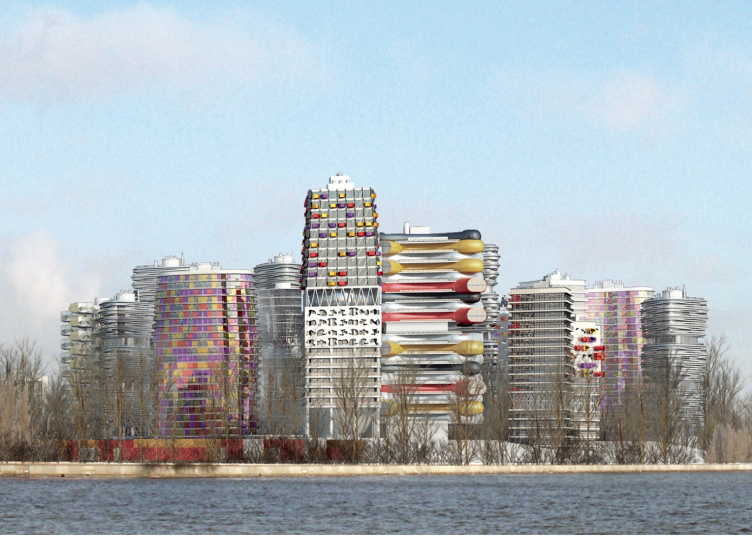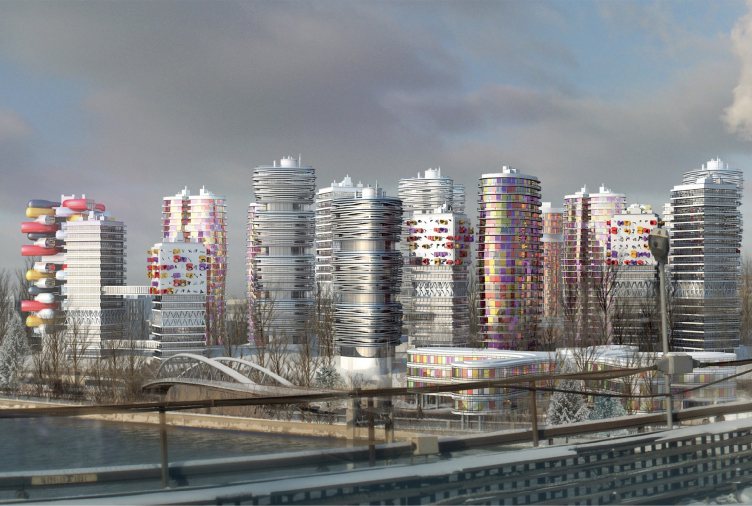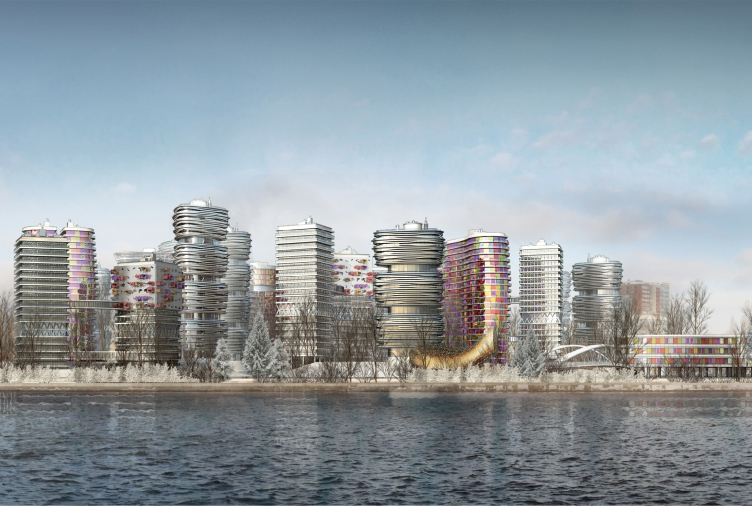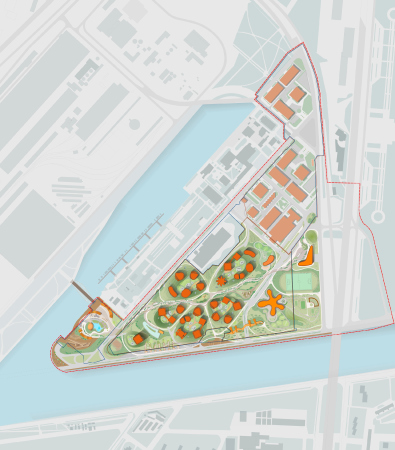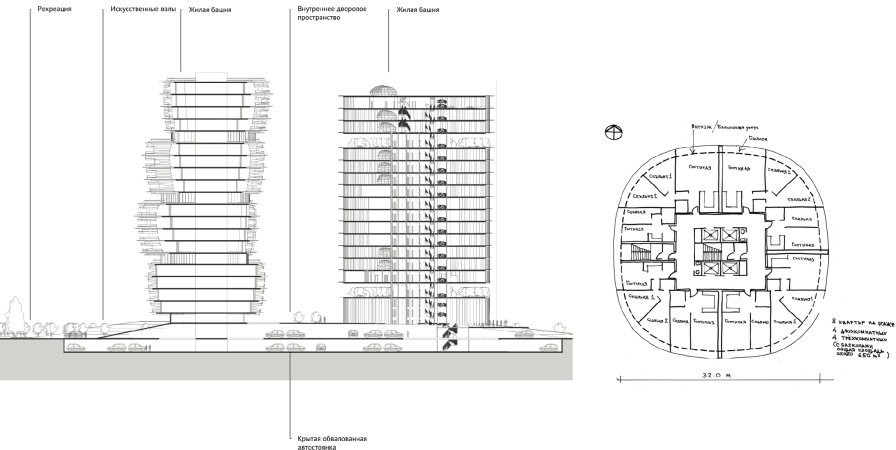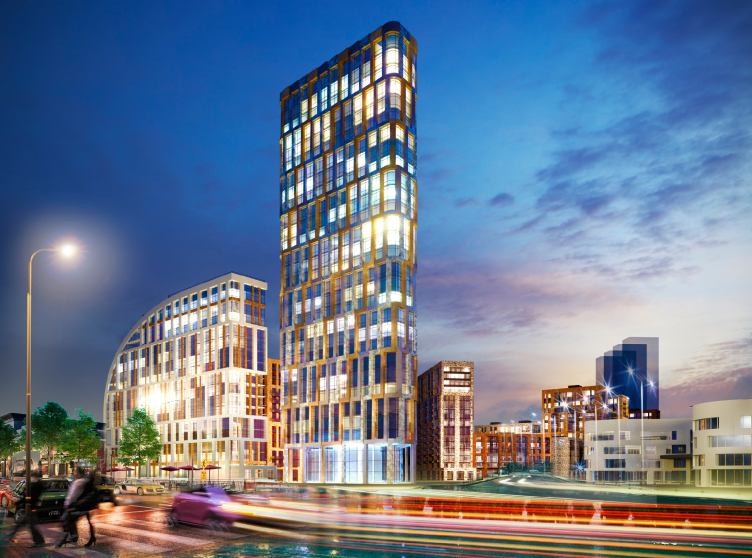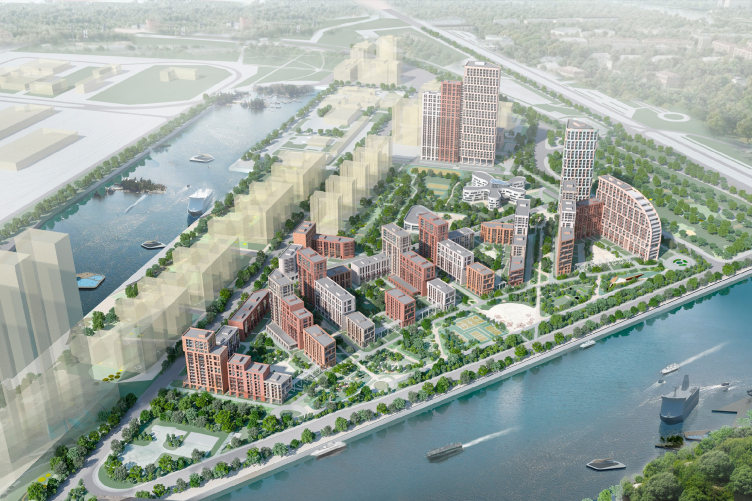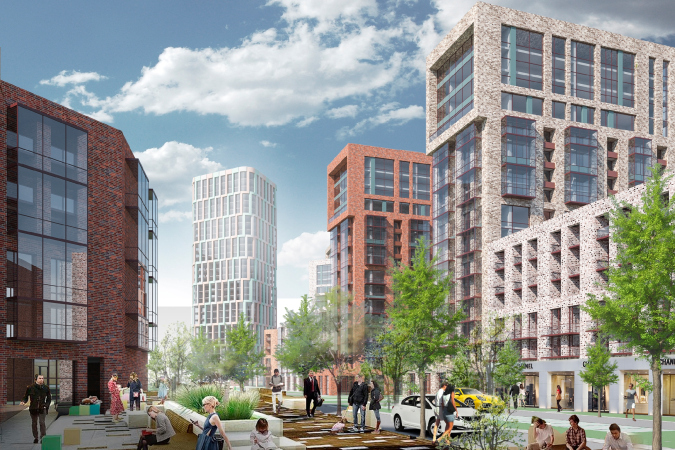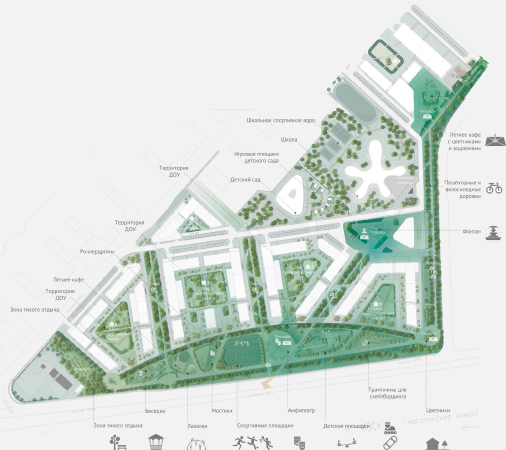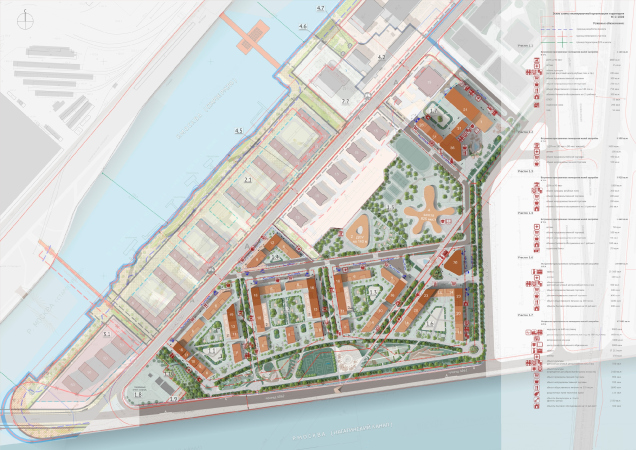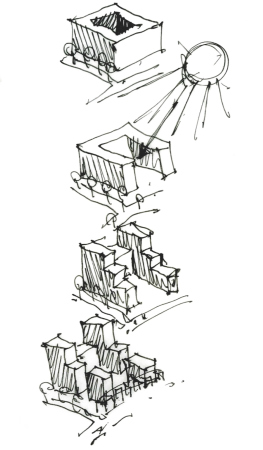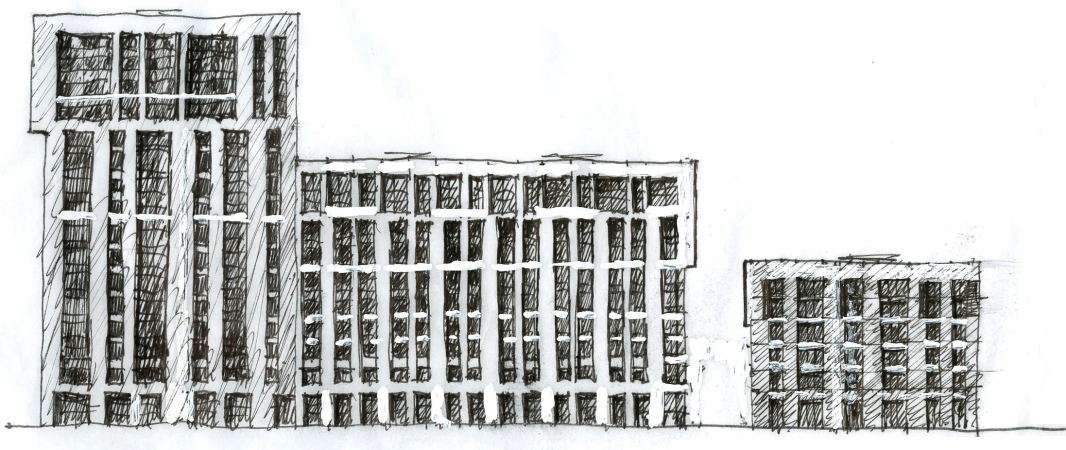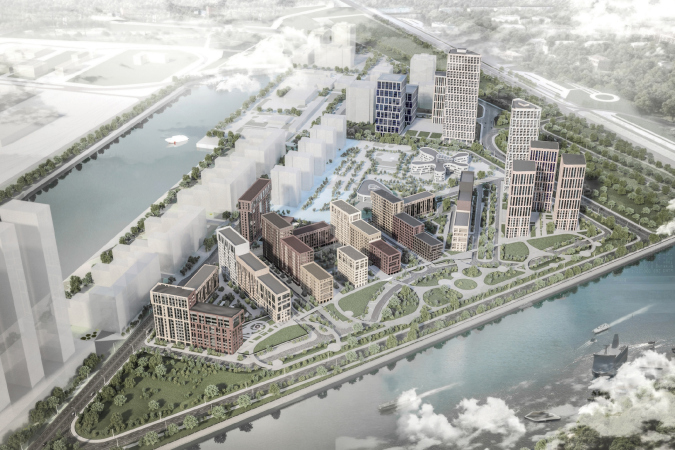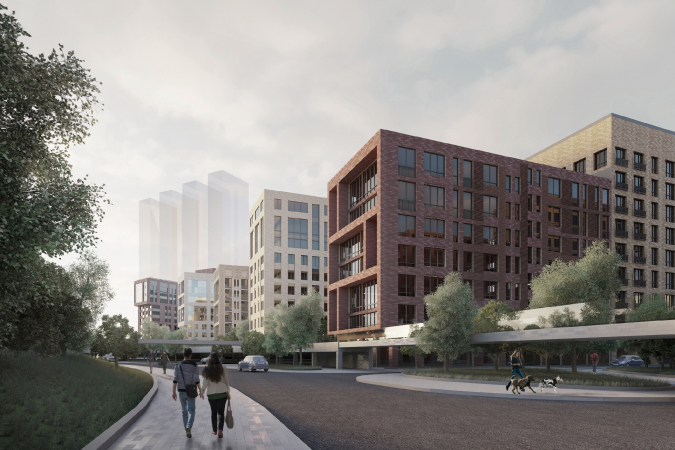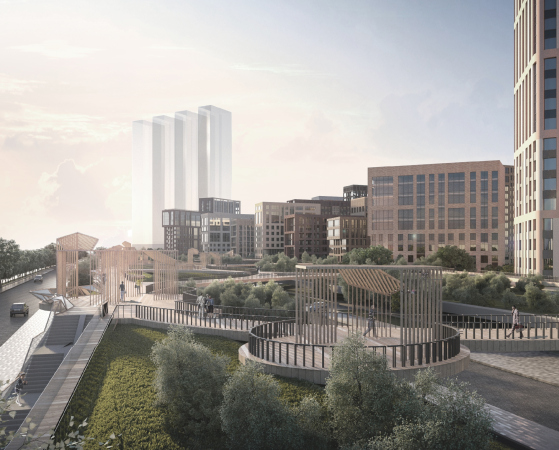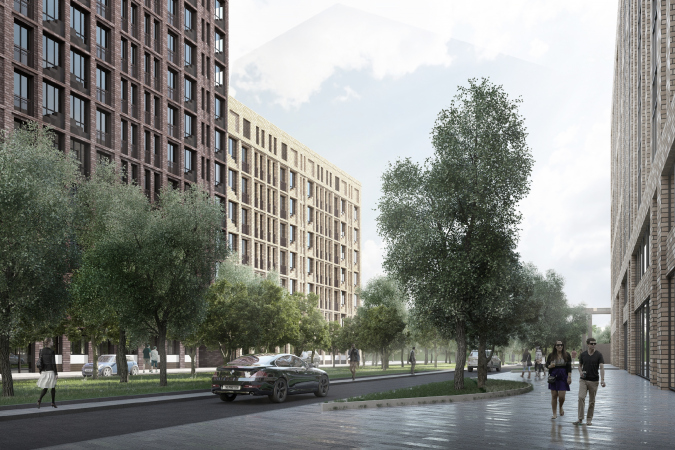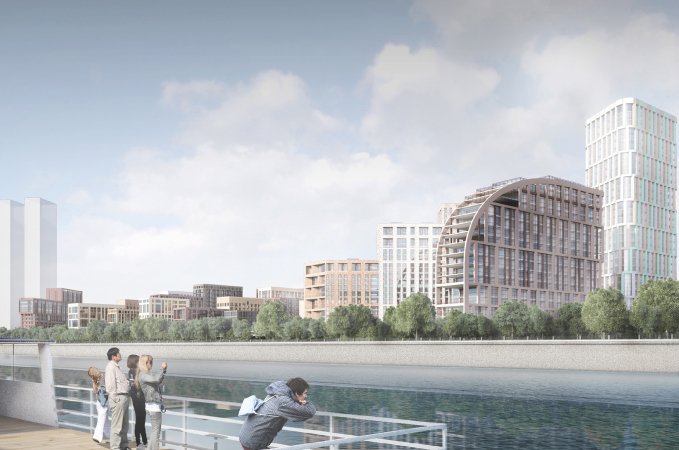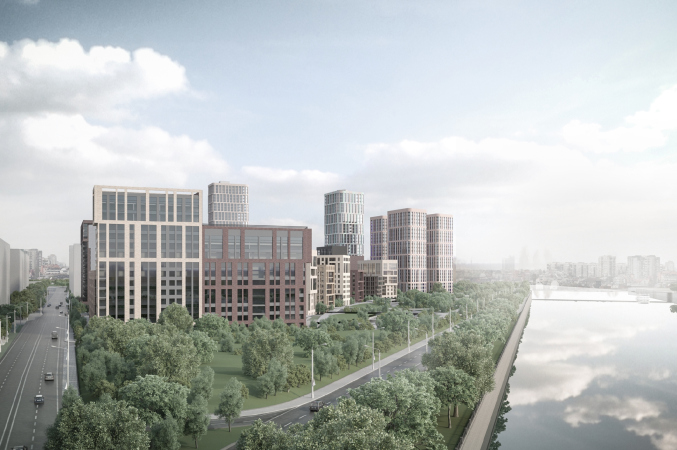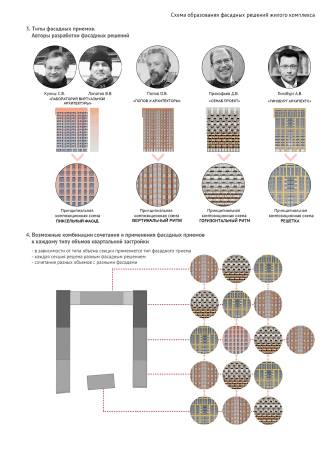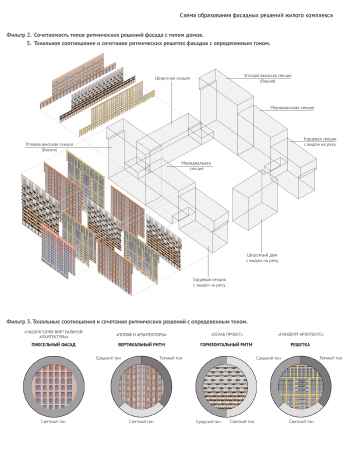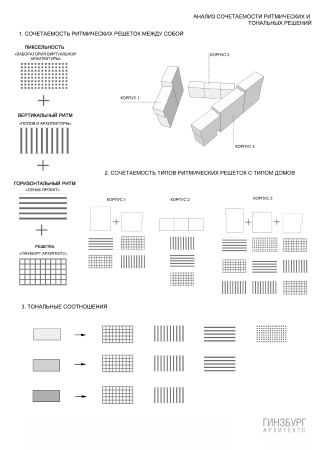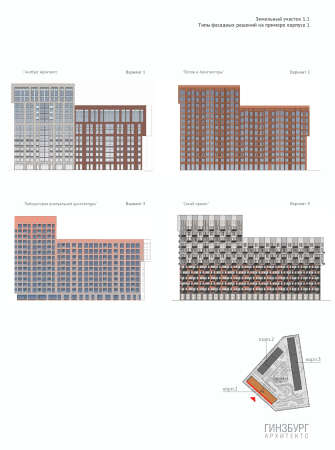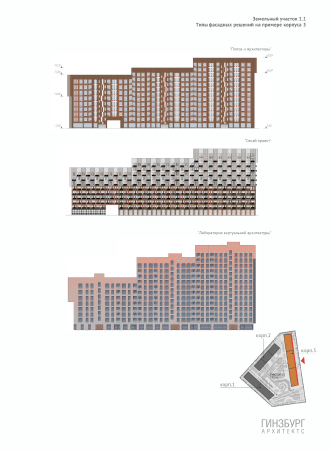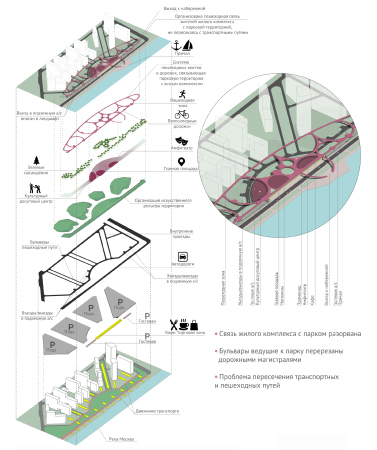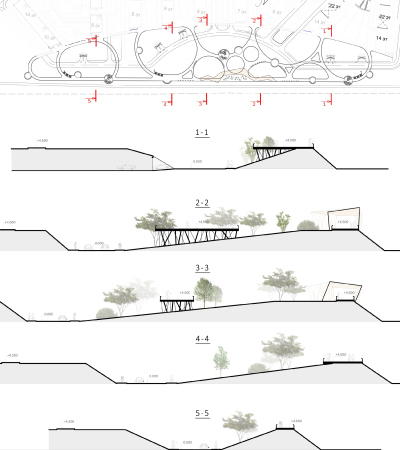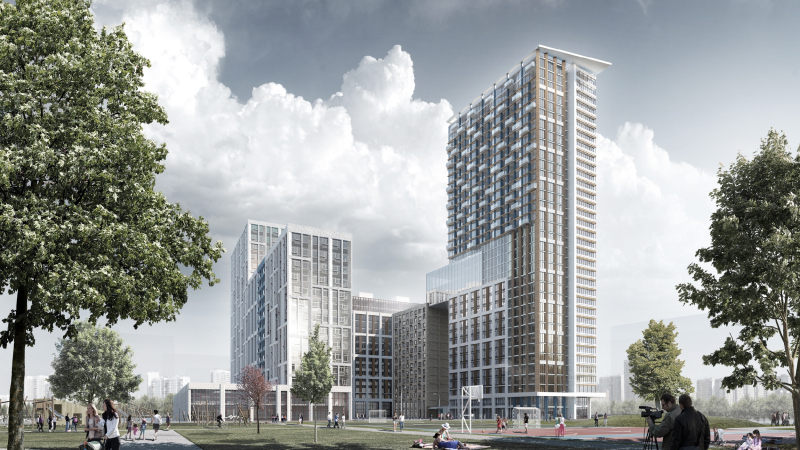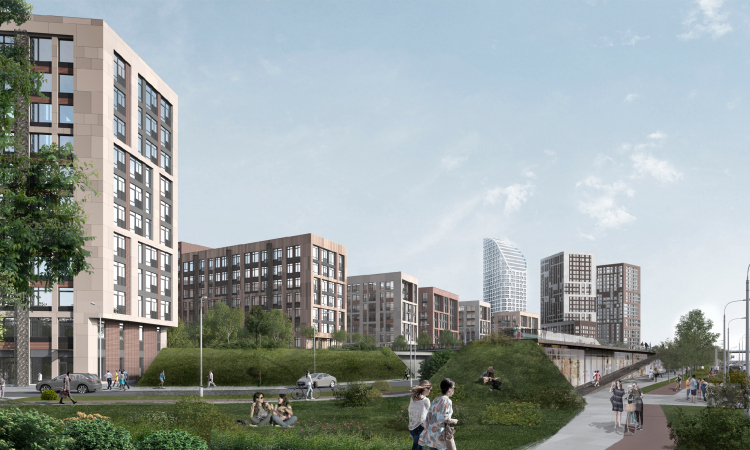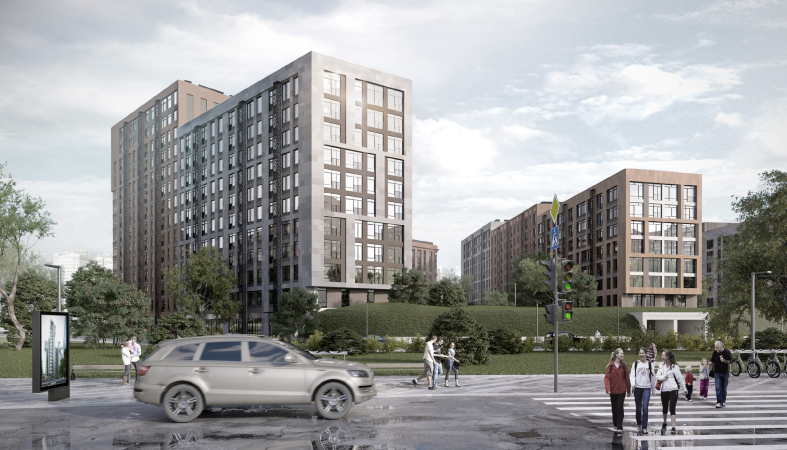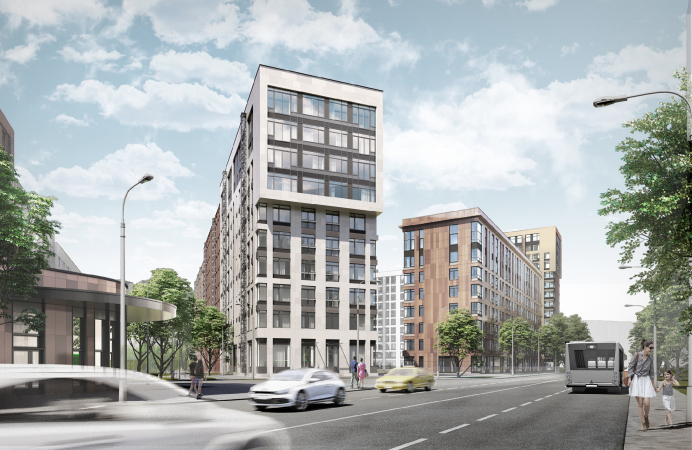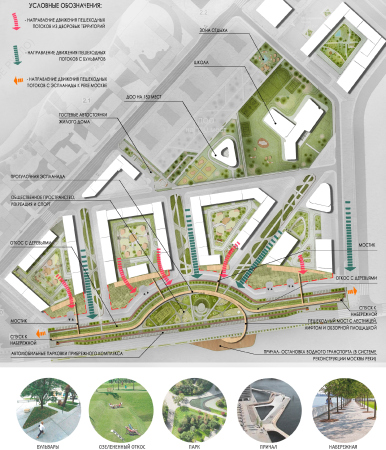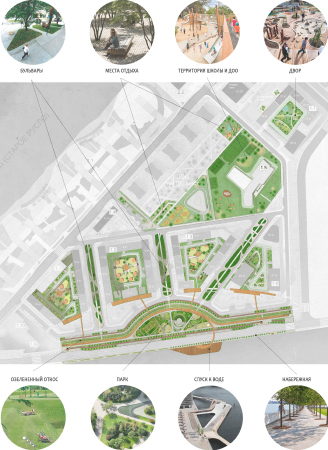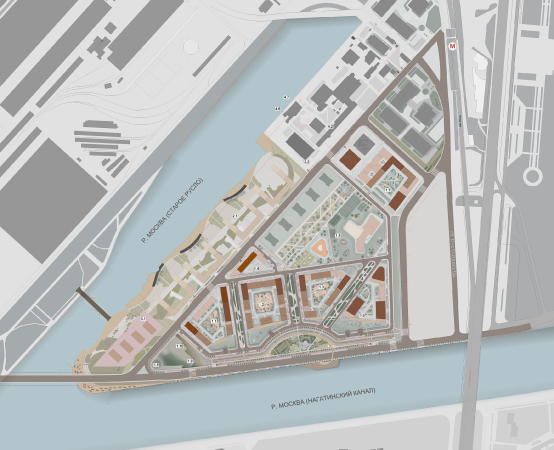The land site in question is essentially a continuation of the industrial construction of the ZIL peninsula, yet still separated from it by the remains of the old riverbed of the Moskva River. Due to this particular circumstance, it looks quite self-sufficient composition-wise. This “minor” peninsula is crossed in its very middle by the Andropov Avenue; its eastern part includes the Ostrov Mechty (“Dream Island”) amusement park, and its western part for years has been the subject of town planning efforts, starting from the late 1980’s, when its conceptual design was done by Vladimir Ginzburg’s architectural studio in Mosproekt. This place is very promising from the town planning standpoint – the land site sports a picturesque “spit” at the confluence or the old and the main riverbeds, a large recreation potential of the riverside lands, and at the same time it is totally context-free, which gives the architects an opportunity to go as fancy with it as they would like. The existing industrial construction is sparse and low-value, and the only thing that can kind of serve as a starting point is the “sail” houses designed by Rimma Aldonina back in the 1970’s, which form the waterfront on the opposite side of the river.
***
2014/ Competition
Right about the time when the ideas for redeveloping the ZIL land took shape, there appeared thoughts about reorganizing its western part and constructing a housing block here. In 2014, the developer conducted the first of the series of competitions for this site, which involved Ginzburg Architects. For Aleksey Ginzburg, this was the first experience of working with the territory. In the first competition, he took part in consortium with two world stars – William Alsop and McAdam Architects.
The competition project for developing stages 3-5 of the Moscow city technopark “Nagatino-ZIL” as integrated construction. 2014.
Copyright: Ginzburg Architects (Moscow), All Design (Alsop Architects, London), McAdam Architects (London)
Architectural and town-planning concept of the mixed-use development in the western part of the Nagatinskaya Poima. Competition project, 2014
Copyright: Ginzburg Architects (Moscow), All Design (Alsop Architects, London), McAdam Architects (London)
The project was very bright, not to say flamboyant. However, the authors did want to make something shocking and conceptual. “During that first competition, I invited a good friend of mine, William Alsop, a great freethinking conceptualist architect; I would even say, there was something rebellious about him – Aleksey Ginzburg reminisces – We proposed a rather uncompromising idea that we thought was doomed from the very start, but we still wanted to make this bold statement”.
Architectural and town-planning concept of the mixed-use development in the western part of the Nagatinskaya Poima. Competition project, 2014
Copyright: Ginzburg Architects (Moscow), All Design (Alsop Architects, London), McAdam Architects (London)
Architectural and town-planning concept of the mixed-use development in the western part of the Nagatinskaya Poima. Competition project, 2014
Copyright: Ginzburg Architects (Moscow), All Design (Alsop Architects, London), McAdam Architects (London)
Architectural and town-planning concept of the mixed-use development in the western part of the Nagatinskaya Poima. Competition project, 2014
Copyright: Ginzburg Architects (Moscow), All Design (Alsop Architects, London), McAdam Architects (London)
In the first competition project, the peninsula’s spit was developed in a highly urbanized way – a “choir” of eccentric-looking towers, each of which could make a worthy exhibit in the museum of modern art. This uncompromising approach was perfectly viable as a new town planning highlight. The proposal was powerful and very elegant imagery-wise – very much in the spirit of William Alsop. The master plan was executed in the shape of a flower; the complex also had a plinth part formed by underground parking garages turned into green hills – because of the high ground water, it was impossible to build parking garages really underground. The space was crossed by a green yard, which was to resurface later in the town planning developments of this territory.
***
2016 / Competition
Architectural and town-planning concept of the mixed-use development in the western part of the Nagatinskaya Poima. Competition project, 2016
Copyright: Aleksey Ginzburg – Chief Architect of the Project; A.Orlov – Chief Architect of the Project; T.Arkhipova – the leading architect
The first competition concept did not get any further development but can now be remembered as a bold creative starting point of developing this land. The next concept came about in 2016, when Aleksey Ginzburg was again invited to the competition – to design the same land site, for which now a territory planning project had been developed. And it was the planning project that served as the brief that was presented to the contestants. The site plan, according to the architects, had a whole number of shortcomings, and, based on these shortcomings, the authors built their new concept.
Architectural and town-planning concept of the mixed-use development in the western part of the Nagatinskaya Poima. Competition project, 2016
Copyright: Aleksey Ginzburg – Chief Architect of the Project; A.Orlov – Chief Architect of the Project; T.Arkhipova – the leading architect
The multifunctional construction, which, in addition to housing, was now serving the public and business functions, was presented in this site plan as urban blocks that were placed alongside the perimeter of the site. On this site plan, the houses stood virtually on the very transportation mainline on the waterfront – the architect shares – We had to stretch the construction in a semicircular fashion so as to pull the buildings away from the traffic way and create a green recreational buffer zone”.
Architectural and town-planning concept of the mixed-use development in the western part of the Nagatinskaya Poima. Competition project, 2016
Copyright: Aleksey Ginzburg – Chief Architect of the Project; A.Orlov – Chief Architect of the Project; T.Arkhipova – the leading architect
The architects tried to turn the residential yards southward as much as possible to make them face the river and the sun; at the same time, the side ends of the houses that were facing the water were used to form the waterfront. Aleksey Ginzburg shares that the green buffer idea came to him from his childhood associations: “I spent my entire childhood in the Architects’ House, which is on the Rostovskaya Embankment near the Kievsky railway station, and I remember that we had this little park that, thanks to the dip of the terrain, served as a screen between the waterfront highway and the residential buildings. This construction was designed still by Aleksey Shchusev as the waterfront in this section of the Moskva River. I thought that the logic of the Nagatinskaya riverbed required a similar solution”.
Since removing the highway was out of the question (it was an important segment of the ZIL transportation scheme) the green buffer zone could advantageously separate the highway from people’s homes and get turned into a mini park. Therefore, the pedestrian boulevard, which was already there on the site plan, was literally carried over to the waterfront, which yielded a rather broad recreational zone.
***
2017 / Development of the competition concept
Ginzburg Architects won the competition, which came as a surprise even for themselves. Aleksey Ginzburg believes that this must have happened thanks to the carefully thought out public space that the project provided for, which also included the thought out plan of traffic and pedestrian flows. While in the stage of detailed elaboration of the project for getting the municipal approvals, Aleksey Ginzburg decided to invite a few other architectural companies to work on the project – the sheer construction volume was quite impressive – about 400 000 square meters. The project was joined by the “Laboratory or Virtual Architecture” header by Stanislav Kulish and Vadim Lipatov, “Popov and Architects”, and “SENAB PROJECT”.
Due to the fact that the apartment plans were predetermined by the client’s brief, the architects focused on the outward appearance of the buildings. The houses within the block were divided into a few types, all the four companies designing the facades for each of them. Striving to maintain, for all the diversity of the individual solutions, the visual integrity of the complex, Aleksey Ginzburg proposed to unify all of the facade designs by obligatory use of brick.
“The shades of brick, as well as the ways and methods of its application, was something that we left to each partner’s discretion – the architect explains – Eventually, we got four patterns, each of which demonstrated an individual designer technique. In the version that was designed by our company, for example, the facade idea was expressed in large segments, while the version proposed by Kulish and Lipstov was essentially about what you might call pixel painting. Then we conducted a series of workshops in order to find the best way for combining our versions, ultimately coming up with a system of factors that would help bye to do this within one urban block on the basis of the compositional analysis”.
Parallel to that, the fourth compositional layer of the land site was developed – the concept of the public spaces. Essentially, it was based on the competition idea of the green buffer zone serving as a screen between the riverside highway and the residential area, adding a whole new level to it – an elevated system of pedestrian promenades, little bridges and ramps, making a landscaped park above the driveways that were originally included in the site plan. On the plan, this layer looked like a grid of large cells that connected the park to the level of the yards, also elevated because of the leveed parking garages.
While this work was in progress, Yuri Grigoryan designed for the city a concept of developing the Moskva River waterfronts, on which interesting “points of growth” appeared – the “ports” or multifunctional public spaces. Aleksey Ginzburg decided to “plug in to this narrative” and turned the already existing quay of the river boat into one of such “ports”, adding to it a semicircular pedestrian bridge. The future park will be called NAGA, which is short for Nagatino. But then again, so far it has remained on the level of conceptual development.
***
2018 / competition
Yet another generation of managers, who replaced the old ones behind the wheel of the seemingly endless project, conducted still another competition in 2018, inviting western stars for participation. Aleksey Ginzburg also took part in this competition as a “long-standing contestant”. And, although the new clients wanted to break away from brick as the main building material in favor of the more budget-friendly prefab panels, the project still inherited a lot of things from the previous iterations. The arrangement of the city blocks changed a little bit, but the idea of a green buffer zone near the river, the elevated leveed parking garages, and the play of levels remained. Here, the architects again put their focus on the waterfront – the authors formed a single construction front from the side ends of the residential houses, creating an effect of a “sliced surface”, as the architect explains. By doing this, they joined by a slight arc all of the four housing blocks from the side of the river. Yet another highlight is the business part – as we remember, the developer considered the block to be multifunctional.
The project of 2018, however, wasn’t realized either. The concept of the territory was re-formatted again, and up to this day there is no clear understanding whether a new project will be developed or the earlier solutions will be implemented. “This large town planning project was something that we repeatedly tried to imbue with progressive ideas, observing the principles of the commercial approach that is dictated by today’s market – Aleksey Ginzburg says – rearranging and repacking these city blocks, never once did we break the rules, which, regrettably, really limit the range of possible architectural solutions. But still I think that we were able to solve two main tasks, the inner one being the task to create a human-friendly environment for the life of people, and the outer one being the task of forming a fragment of city fabric that would have both compositional and aesthetic connections with the Moscow environment”.




